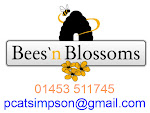It's now only 2 weeks until we meet for the YABeeP bumble/solitary bee day on 5th December.
The purpose of the day is to build bumblebee nest boxes and/or solitary bee homes either as useful Christmas presents to give, or for your own use. Click here to see the YABeeP bumblebee home plans, or here to see an excellent example solitary bee box by Marc Carlton.
We will be meeting at Ray's in Cheddar (an email with venue details has been sent to YABeeP members). The meeting will start at 10:00 am, but come along when you can. It would help Ray if you could let him know if you are attending either by phone or email.
Jon will be providing some pallet planks and bits of timber he has managed to purloin (!) but if you have, or see in a skip, any of the following materials then please bring them on the day and we can make use of them:
- bamboo canes
- pallet planks, whole pallets or misc planking
- logs of varying firewood sizes
- 4" x 2" pieces of timber (or larger)
- perspex sheeting
- bits of chicken wire or similar
Similarly, we will be providing the necessary tools but if you want to bring your own please do.
See you there or at the YABeeP Christmas drink on 7th December.
Robin & Jon
UPDATE: 29 Nov:
I am pleased to say that Marc Carlton form the Gardens for Wildlife website is joining us on Saturday 5th December from Chepstow. He will kindly give us a quick chat drawing from his experience on bumbles and solitaries before we start so we can adapt our boxes accordingly.
Because of a tip he has already passed on to me can I ask any of you who have family pet mice, rats, gerbils, etc. to collect old bedding you clean out and bring it on the day. Apparently the 'aroma' of old mice bedding is a bumblebee attractant - pooh! 
© Robin Morris - YABeeP





















